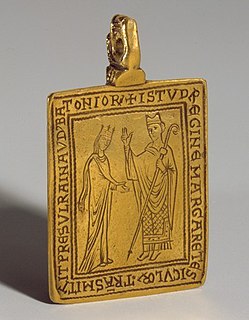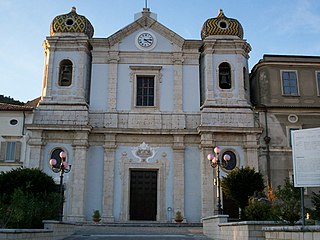John of Ajello [1] (died 4 February 1169) was the Bishop of Catania from November 1167 until his death. He was a brother of the chancellor Matthew of Ajello.
Since the death of the last incumbent 1162 the see of Catania had been vacant. In 1167 an election was disputed between William of Blois, one of the French party that had come to Sicily in the following of the chancellor Stephen du Perche, and John, who had the support of the "xenophobe party" opposed to the French. John's election was confirmed by November, when the chronicler Hugo Falcandus referred to him as "electus" when implicated him in the poisoning of Robert of Bellême. John's election was confirmed by Pope Alexander III on 26 July 1168.
John died in the earthquake of 4 February 1169. In a letter to William, his brother, the poet Peter of Blois, praised John's death as fitting punishment from God.

Salerno is an ancient city and comune in Campania and is the capital of the namesake province. It is located on the Gulf of Salerno on the Tyrrhenian Sea. In recent history the city hosted Victor Emmanuel III, the King of Italy, who moved from Rome in 1943 after Italy negotiated a peace with the Allies in World War II, making Salerno the capital of the "Government of the South" and therefore provisional government seat for six months. Some of the Allied landings during Operation Avalanche occurred near Salerno. Today Salerno is an important cultural and economic centre in Campania and Italy.

Tancred was King of Sicily from 1189 to 1194. He was born in Lecce an illegitimate son of Roger III, Duke of Apulia by his mistress Emma, a daughter of Achard II, Count of Lecce. He inherited the title "Count of Lecce" from his grandfather and is consequently often referred to as Tancred of Lecce. Due to his short stature and unhandsome visage, he was mocked by his critics as "The Monkey King".

Constance I was reigning Queen of Sicily from 1194–98, jointly with her spouse from 1194 to 1197, and with her infant son Frederick II, Holy Roman Emperor, in 1198, as the heiress of the Norman kings of Sicily. She was also Holy Roman Empress and later Dowager by marriage to Henry VI, Holy Roman Emperor.

Reginald fitz Jocelin was a medieval Bishop of Bath and an Archbishop of Canterbury-elect in England. A member of an Anglo-Norman noble family, he was the son of a bishop, and was educated in Italy. He was a household clerk for Thomas Becket, but by 1167 he was serving King Henry II of England. He was also a favourite of King Louis VII of France, who had him appointed abbot of the Abbey of Corbeil. After Reginald angered Becket while attempting to help negotiate a settlement between Becket and the king, Becket called him "that offspring of fornication, that enemy to the peace of the Church, that traitor." When he was elected as a bishop, the election was challenged by King Henry's eldest son, Henry the Young King, and Reginald was forced to go to Rome to be confirmed by Pope Alexander III. He attended the Third Lateran Council in 1179, and spent much of his time administering his diocese. He was elected Archbishop of Canterbury in 1191, but died before he could be installed.
Stephen du Perche was the chancellor of the Kingdom of Sicily (1166–68) and Archbishop of Palermo (1167–68) during the early regency of his cousin, the queen dowager Margaret of Navarre (1166–71).
Nicholas of Ajello was the second son of the Sicilian chancellor Matthew of Ajello and the archbishop of Salerno from 1181, when he succeeded the historian Romuald Guarna. He was a trusted advisor in the Norman Kingdom of Sicily at the time of its fall to Henry VI, Holy Roman Emperor (1194).
Romuald Guarna was the Archbishop of Salerno from 1153 to his death. He is remembered primarily for his Chronicon sive Annales, an important historical record of his time.
Matthew of Ajello was a high-ranking member of the Norman court of the Kingdom of Sicily in the 12th century. His brother John was a bishop.
Richard Palmer, an Englishman, was the bishop of Syracuse from 1169 and archbishop of Messina from 1182. Palmer first rose to prominence in 1160 as one of the triumvirate of grandees who replaced the assassinated Admiral Maio of Bari. He was "a man of great learning and eloquence," according to Hugo Falcandus.

Sibylla of Acerra (1153–1205) was Queen of Sicily as the wife of King Tancred. She was regent in 1194 for their son, King William III. She was the sister of Count Richard of Acerra.

Giovanni Visconti (1290–1354) was an Italian Roman Catholic cardinal, who was co-ruler in Milan and lord of other Italian cities. He also was a military leader who fought against Florence, and used force to capture and hold other cities.

The Italian Catholic Diocese of Cerreto Sannita-Telese-Sant'Agata de' Goti, in Campania, Italy, has existed since 1986, when the Diocese of Sant'Agata de' Goti was united into the historical Diocese of Telese-Cerreto Sannita. The diocese is a suffragan of the Archdiocese of Benevento.

The Archdiocese of Siracusa, also known as Syracuse, is a Latin Church ecclesiastical territory or diocese of the Catholic Church in Sicily. It became an archdiocese in 1844. The current archbishop is Francesco Lomanto.

The Archdiocese of Catania is a Roman Catholic ecclesiastic territory in Sicily, southern Italy, with its seat in Catania. It was elevated to an archdiocese in 1859, and became a metropolitan see in 2000. Its suffragans are the diocese of Acireale and the diocese of Caltagirone.
Events from the year 1587 in art.
The Diocese of Cava was a Roman Catholic diocese located in the Italian region Campania. It existed from 1394 to 1986, and was informally known as Cava and Sarno from 27 June 1818 to 25 September 1972 while in union with the neighboring Diocese of Sarno.

Aiello is a surname of Italian origin. People with the name include:
The 1169 Sicily earthquake occurred on 4 February 1169 at 08:00 local time on the eve of the feast of St. Agatha of Sicily. It had an estimated magnitude of between 6.4 and 7.3 and an estimated maximum perceived intensity of X (Extreme) on the Mercalli intensity scale. The cities of Catania, Lentini and Modica were severely damaged, and the earthquake also triggered a tsunami. Overall, the earthquake is estimated to have caused the deaths of at least 15,000 people.
William of Blois was a French medieval poet and dramatist. He wrote at least one poetical work, which has not survived, as well as some dramas. Two other works that survive are credited to him, but it is not clear if he was actually the author. He also was an abbot of a monastery in Calabria in southern Italy, after being an unsuccessful candidate for the Bishopric of Catania in Italy.
Santa Maria della Matina was a monastery near San Marco Argentano in Calabria. It was originally Benedictine, but later became Cistercian.









